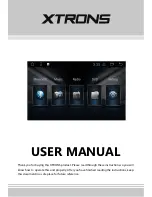
Wireless Intercom System
Theory of Operation and Diagrams
1-5
E
3M 2003
March
Base Station
n
Note
Receiver/transmitter and logic circuitry contained
in the base station is both proprietary and non-field
repairable. For this reason, the accompanying base
station diagram provides no circuit component
detail. Only those details that assist fault isolation
(such as connections, configuration jumpers, audio
control circuits, replaceable components and
input/output functions) are shown.
DC Power
DC power for the base station circuits and external
components is provided as follows:
A self-contained DC power transformer, connected to
120VAC, provides unreg12VDC to the base
station power input jack. The +12VDC is turned on
or off by a slide switch located on the front of the base
station. The unregDC is routed through a
protective polyswitch (circuit breaker) to circuit
components and a voltage regulator (called power
supply in the diagram). If an overcurrent condition
causes the polyswitch to open, it automatically resets
after power is removed.
The unreg12VDC is used by the vehicle
detector to provide a +DC vehicle detect signal to the
base station vehicle detect circuits. If an interconnect
module is used in the system, unregDC is
provided to energize the interconnect module relays.
Talk/Page Input
Talk and page voice communications transmitted from
the headset are received along with their
accompanying “talk” or “page” control tones.
Received talk communications are routed by the
RCVR & RCVR LOGIC as follows:
S
To the menu sign speaker amplifier via the
DAY/NIGHT volume controls and DAY/NIGHT
switch, through the amplifier to the menu sign
S
To the monitor speaker amplifier via the MON
TALK volume control, through the amplifier and
the Master Monitor Volume control to the monitor
speaker
S
Through the transmit amplifier to the TXMT &
TXMT LOGIC for transmission to all headset
receivers and to output connector AUDIO OUT
for use in cross-lane applications
Received page communications are routed by the
RCVR & RCVR LOGIC as follows:
S
To the monitor speaker amplifier via the MON
PAGE volume control, through the amplifier and
the Master Monitor Volume control to the monitor
speaker
S
Through the transmit amplifier to the TXMT &
TXMT LOGIC for transmission to all headset
receivers, and to output connector AUDIO OUT
for use in cross-lane applications
Vehicle Detector Input
Upon detection of a vehicle, the vehicle detector
signal will be a steady DC or a short-duration DC
pulse depending on whether the vehicle detector is a
“presence” or “pulse” type detector. Upon receipt of
the vehicle detect signal, the VEHICLE DETECT
LOGIC circuit emits alert tones. These alert tones are
routed as follows:
S
To the monitor speaker amplifier via the MON
ALERT volume control, through the monitor
speaker amplifier and the Master Monitor volume
control to the monitor speaker
S
To the transmit amplifier via the Headset Alert
Level control, through the amplifier to the TXMT
& TXMT LOGIC for transmission to all headset
receivers
S
To output connector ALERT OUT for use in
cross-lane applications
n
Note
The vehicle detect PULSE/PRESENCE jumper J4
must be set appropriately and its setting
programmed into the base station logic for correct
vehicle detection and alert tones to occur. For
further explanation of vehicle detect alert tones,
refer to the paragraphs titled
Vehicle Alert System
and
Vehicle Detector Input
in this section.
Содержание C860
Страница 2: ......
Страница 12: ...Wireless Intercom System Theory of Operation and Diagrams 1 8 E 3M 2003 March Blank Page...
Страница 14: ...Theory of Operation and Diagrams Wireless Intercom System 1 10 3M 2003 March Blank Page...
Страница 16: ...Wireless Intercom System Theory of Operation and Diagrams 1 12 E 3M 2003 March Blank Page...
Страница 17: ...Wireless Intercom System Theory of Operation and Diagrams 3M 2003 March 1 13...
Страница 18: ...Wireless Intercom System Theory of Operation and Diagrams 1 14 E 3M 2003 March Blank Page...




































